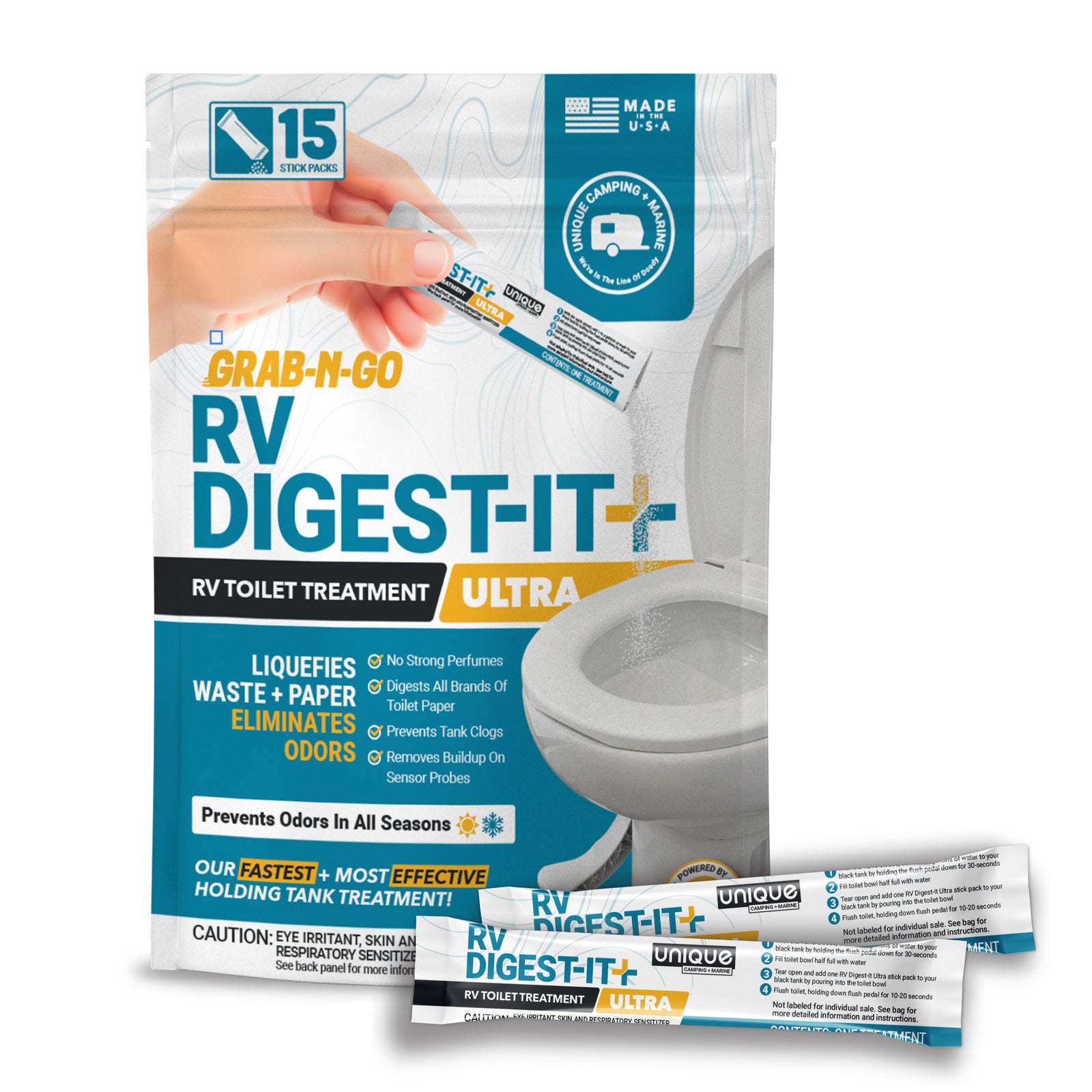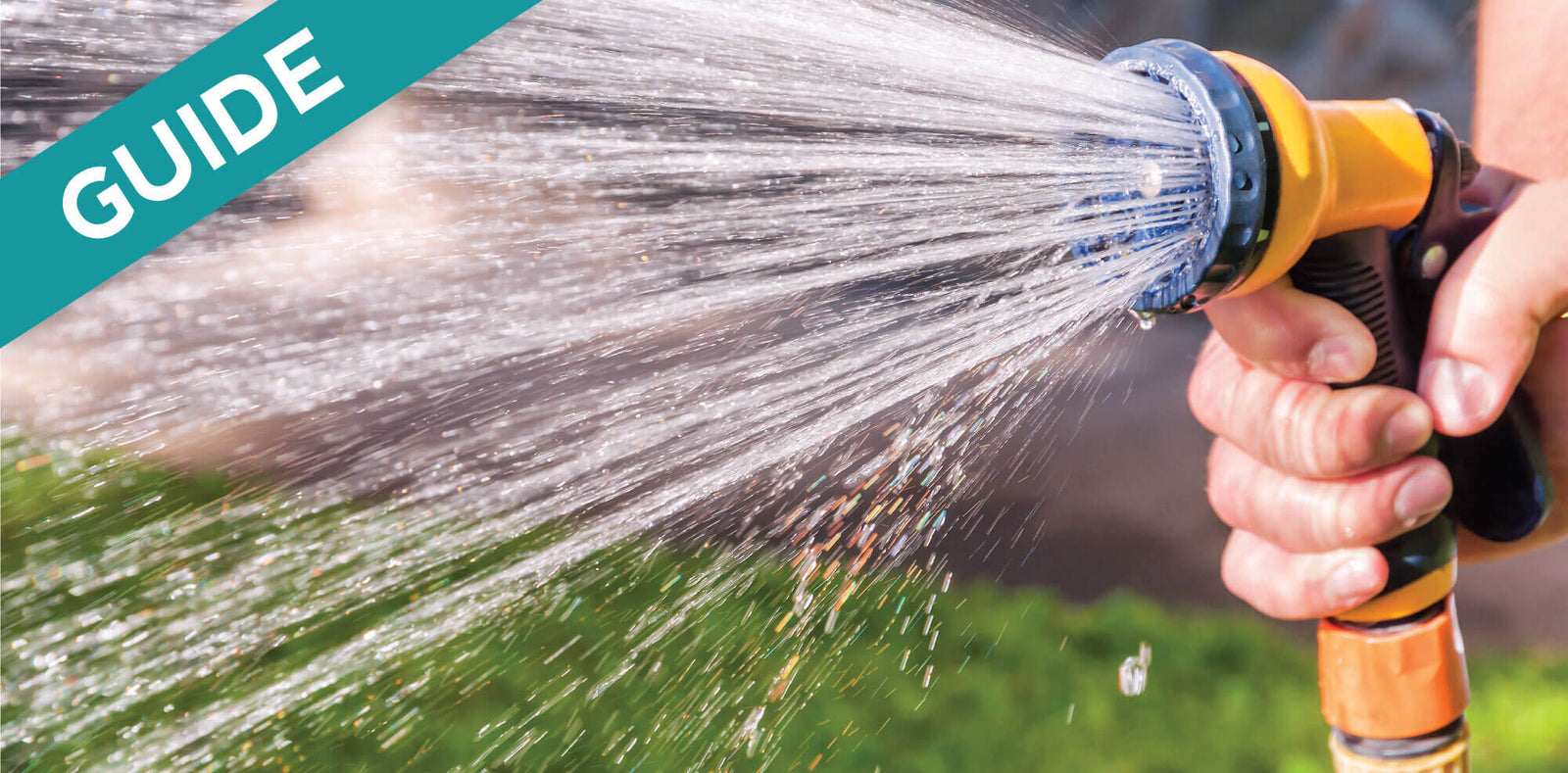
Article 5 of 5 in Series: RV Holding Tank Sensors
Read series from the beginning
- Prevent black tank sensor misreadings by using high-quality bacteria-based tank treatments, applying the right cleaning habits, using plenty of water, controlling the amount of toilet paper that goes in, and storing your RV with a full black tank of fresh water and Restore-It (when there’s no danger of freezing).
- Prevent gray tank sensor misreadings by keeping your gray valve open while on hook-ups, applying the right cleaning habits, and controlling the grease and food debris that goes in.
- Consistently following The Unique Method is the best way to prevent sensor issues.
It’s so satisfying when you have fixed a misreading sensor and are now enjoying the luxury of your RV with the confidence that your tank is as full or empty as the level monitor indicates. But the real question becomes, how can you continue that accuracy for many trips? It’s a really simple answer: follow The Unique Method. This carefully crafted process of recommended RV tank products and tank care habits will keep your sensors clean even while using the tanks, so start using it today to kick those sensor issues to the curb. In the meantime, here are some specific habits taken right out of The Unique Method’s guidelines for each tank and why they help prevent sensor problems.
Preventing Black Tank Sensor Misreadings
As you’ve read in previous sensor articles, black tank sensors misread for the same reasons that gray tank sensors do (something is covering the sensor), but the type of things that cover the sensor are different. Here are some habits that will help you keep your black tank sensors working properly.
-
Use a high-quality, waste-digesting tank treatment to help liquefy the waste. Choosing a product like this is one of the best decisions you can make for your tank. A bacteria-based tank treatment (like Unique RV Digest-It Plus) will do all the things you want a tank treatment to do (break down waste and control odors) and it will clean the sensors in the process. That’s right! Your tank treatment cleans the sensors without having to buy an extra, specially labeled product to clean sensors. Win, win!
Guide: Why You Should Use a High-Quality Waste Digester in Your RV
- Thoroughly flush/rinse your tank minutes after every dump.Rinsing your black water tank is more important than you might realize. When the tank drains, even liquefied waste will cling to the walls as the water level decreases, and if you leave that thin film of black water waste sticking to the walls every time you dump, it can easily create enough buildup on the tank sensors to cause them to misread. This will also help clear out toilet paper and solid debris that can get stuck on the sensors, preventing those stragglers from getting stirred up next time the tank fills and clinging to the sensor probes.
- Deep clean your tank using Unique Clean-It at the start and end of the season (dry campers/boondockers) or every 5-10 dumps (full-time RVers). You might think that constant rinses after every dump would negate the need for deep cleaning, but no. Rinsing alone will not guarantee that waste won’t build up in your tank, which is why consistent deep cleaning is still necessary. Unique Tank Cleaner (used to deep clean tanks) has a much higher concentration of bacteria and enzymes to break up lingering waste buildup you may not even know is there. Full-time RVers with permanently parked units could have waste gathered in low spots, and deep cleaning is the only thing that will remedy this problem. Deep cleaning while still using the tanks is a little more challenging, but our guide on deep cleaning walks you through how to modify that cleaning process.
-
Use lots of water in your black tank by holding down your flush pedal for at least 10 seconds on every flush. Depriving your black tank of all the water it needs could lead to lots of solid waste building up, which can easily block the sensors. We know using more water freaks out avid dry campers/boondockers who try to conserve water, but even on a boondocking trip, it’s important to use a fair amount of water in your black tank, especially if you are treating it with a bacteria and enzyme tank treatment. The bacteria in these types of treatments need water to live and the water also provides a path for both the bacteria and the enzymes to reach the waste and break it down.
Guide: Why Using Lots of Water in your RV Toilet and Tanks is Crucial
- Don’t use too much toilet paper. We all like to ensure that we’re clean after vacating the throne, but using a lot of toilet paper can make things dicey for the tank sensors, especially if the toilet paper you use doesn’t break down as well as it should for an RV holding tank. People often wonder if they should be using RV-specific toilet paper, but we believe that if you are using a high-quality, bacteria-based tank treatment, the type of toilet paper won’t matter that much. However, it’s still prudent to choose a brand of toilet paper that will break down quickly.
- If your RV will be stored for even a short amount of time, consider storing it with a full black tank of water and an entire bottle of Restore-It (when there is no danger of freezing). It seems like this tip is contradictory to our recommendations in favor of storing your RV with empty tanks, but as long as there is no chance of freezing, storing your black tank full of water and Sensor Cleaner for a while will help ensure that sensors are reading correctly on your next camping trip. This simple between-trips habit will prevent waste that is stuck on sensors from drying out and becoming a much more annoying problem. Weekend warriors can easily store it this way for a week and then dump as soon as you get to the campground or in your home cleanout before you leave.
Preventing Gray Tank Sensor Misreadings
Gray tank sensors misread more often when you are consistently keeping your gray valve closed while in use. Hook-up campers who keep their gray valve open all the time typically do not have much trouble with sensors because the water level never gets high enough for accumulated grease and oils to cling to the sensors. RVers who often camp with their gray water valve closed may want to perform frequent gray tank sensor cleanings to stay ahead of grease and oils that could stick to the sensors. Here are some habits that will help you keep your gray water sensors working properly.
-
If you’re on hook-ups, keep your gray tank valve open with a p-trap in the hose. There is really no need to keep your gray valve closed while on sewer hook-up, and by doing this, you protect your upper level tank sensors from being caked with grease and oils. It’s still a good idea to deep clean your gray tank frequently even if you always keep the gray valve open because grease and oils will still accumulate on the floor of the tank and could lead to odors. If you’re not on sewer hook-up and need to keep your gray water valve closed, the best practice is to clean your gray tank with Dawn Ultra on the last night of your trip or just before you dump (for full-time boondockers). Cleaning RV tank sensors with Dawn Ultra is basically the same process as deep cleaning your tank with Dawn Ultra, so refer to our guide on Deep Cleaning RV Wastewater Holding Tanks for step-by-step instructions.
Guide: The Definitive Guide to Using Your RV Waste Water Valves
- Wipe your dishes of food particles and grease as much as possible before you wash them. This is a great habit to create because when you have to keep your gray valve closed, any amount of grease, oil, and even food debris could end up clinging to your sensors, especially as the water level drops when you’re dumping. Think of a sink full of water and greasy dishes. The oil floats on the surface and as the water level drains, the oil and even some food debris clings to the edges of the sink. You have to spray it off to stop it from staining the sink or drying out on the sink walls. Keeping grease and oil from getting into the gray tank will reduce the likelihood of sensors misreading.
- Use a sink strainer to catch rogue food particles from going down the drain. Sink strainers are an easy solution to catch the small particles of food from dishes that you may not have been able to wipe off. It’s just one more line of defense to keep your gray tanks free of debris that could cause sensor misreads.
- Use Dawn Ultra dish soap to wash your dishes (maybe even pour a little down the sink to get ahead of the grease). You might have heard us say many times that Dawn Ultra is the best product to use to clean your gray/galley tanks, but if you have decided to also treat your gray/galley tanks with a bacteria and enzyme product, then using Dawn Ultra to wash dishes and even your hands is also a great decision. We like this product to clean tanks because it breaks up grease very well, and the bonus is that it won’t disturb the good bacteria you’ve added to the tank through treatments like Unique RV Digest-It Plus. If you decide to use some other brand of dish soap, consider using one that isn’t antibacterial so the effectiveness of the tank treatments is not affected.
- Deep clean your gray tank on the last night of every dry camping/boondocking trip or every 3-5 dumps (hook-up campers who keep their gray valve open). Because there is no way to rinse the gray tank as you do the black tank, it’s important to deep clean the gray tank with Dawn Ultra as often as you are able. For those who constantly use their RV with the gray valve closed, it’s especially important to do this on the last night of every camping trip to make sure your sensors don’t start misreading from built-up layers of grime. Campers who usually have their gray valve open on hook-ups don’t have to deep clean that frequently, but we still recommend doing it every time you dump or once you begin smelling odors coming from your gray tank.
Review
We can boil down all the tips for preventing sensor misreadings into one statement: follow The Unique Method. Consistently following The Unique Method’s guidelines for treatment products and tank care habits will help prevent the majority of RV tank sensor problems before they happen, so start using it today! Here’s a brief review of what we covered in this guide:
Preventing Black Tank Sensor Misreadings
- Use a high-quality, waste-digesting tank treatment to help liquefy the waste.
- Thoroughly flush/rinse your black tank after every dump.
- Deep clean your black tank using Unique Tank Cleaner at the start and end of the season (dry campers/boondockers) or every 5-10 dumps (full-time RVers).
- Use lots of water in your black tank by holding down your flush pedal for at least 10 seconds on every flush.
- Don’t use too much toilet paper or use a rapidly dissolving toilet paper brand.
- If your RV will be stored for even a short amount of time, consider storing it with a full black tank of water and an entire bottle of Restore-It (when freezing is not a concern).
Preventing Gray/Galley Tank Sensor Misreadings
- If you’re on sewer hook-up, keep your gray tank valve open with a p-trap in the hose.
- Wipe your dishes of food particles and grease as much as possible before you wash them.
- Use a sink strainer to catch rogue food particles from going down the drain.
- Use Dawn Ultra dish soap to wash your dishes and your hands so the good bacteria in your gray tank is not negatively affected.
- Deep clean your gray tank on the last night of every dry camping/boondocking trip or every 3-5 dumps for hook-up campers who keep their gray valve open.
As an Amazon Associate, Unique Camping + Marine earns from qualifying purchases


Misreading Sensors? We Can Help!
Misreading tank sensors are very common and in most cases pretty simple to fix! We’ve helped thousands of RVers restore their misreading sensors in their RV black and gray tanks, and this Field Guide (our free downloadable PDF) is going to help you!
Get The Free Download



